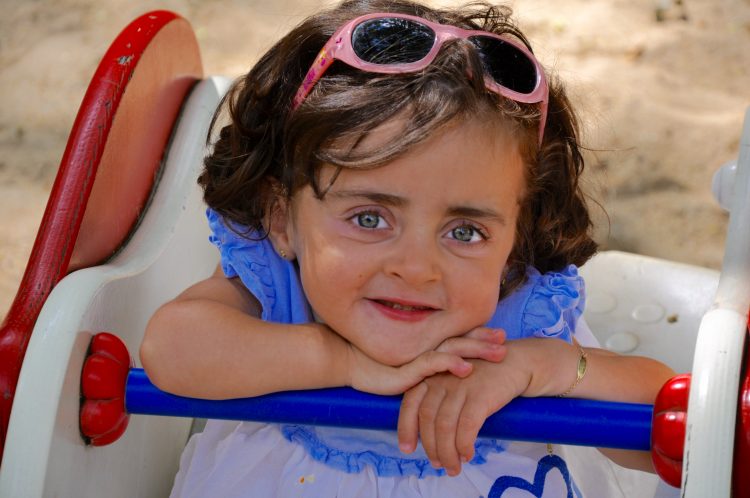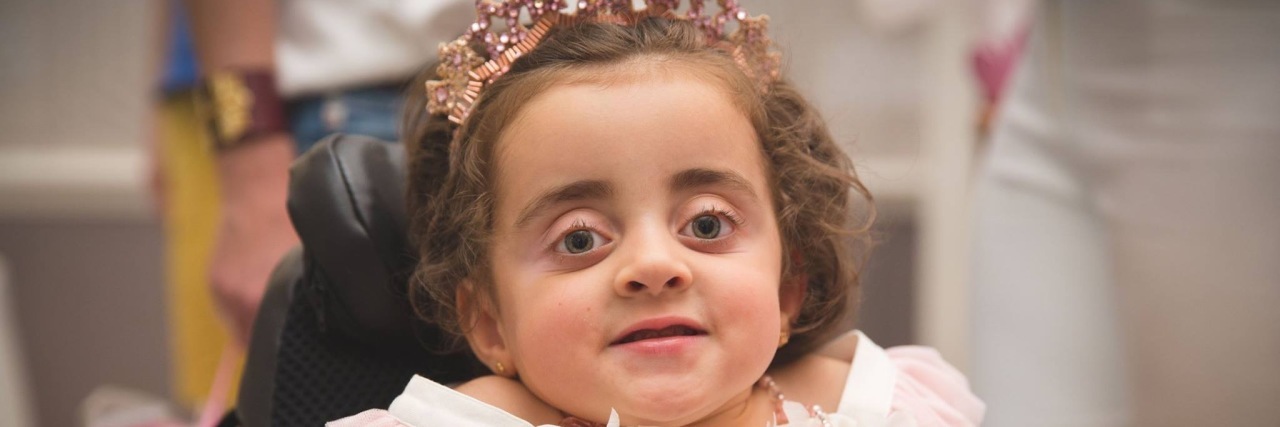My daughter Olivia is 5 years old and has a life-limiting condition. It is an extremely rare form of dwarfism, called Goldblatt syndrome. Olivia is the 18th child diagnosed with this condition worldwide.
Olivia’s symptoms include extreme short stature, joint laxity, scoliosis, flattened vertebrae, hypermobility, neck instability, low muscle tone, narrow chest cavity, and weak tooth enamel called dentinogenesis imperfecta (DI). She cannot walk independently due to her spinal curvature and disproportionate head-to-body size. She has remained at 67 cm since the age of 10 months.
By the age of four months, we began to recognize Olivia was shorter than her peers. She was to lift and pivot her head, and she screamed whenever she was put onto her stomach for tummy time. At eight or nine months, Olivia was sitting unaided, but was very reluctant to stand on her legs and bear her weight. She could not roll over or crawl. It was at this point I began to seek answers from our GP and pediatrician. However, no one would listen to my concerns, stating “every child develops differently.”
We experienced a very difficult time in our journey to finding a diagnosis. Initially Olivia was misdiagnosed with Morquio syndrome. It was only through radiographic images months later that we received a clinical diagnosis of Goldblatt syndrome. However, in 2015, genetic testing of the Goldblatt syndrome gene from Lausanne University was negative, highlighting the possibility of a mutation of the gene. In 2016, we submitted DNA for the Development Deciphering Disorders (DDD) Project and the 100,000 Genomes Project, both of which recently returned inconclusive. Next steps are currently unclear according to our geneticists. What can be done to help solve this quandary?
Since Olivia was nine months of age, I have been on an endless pursuit chasing consultant’s opinions from around the world. With the advice of family and friends, and the internet, specialists with expertise in skeletal dysplasia would pop up and I would spend my days contacting them, begging for help. What can they do to help my daughter? What does the future hold? Have they ever met a child with Goldblatt syndrome? Will Olivia ever walk independently?
In the beginning, it was difficult for me to bond with Olivia. I treated her as a fragile baby, fearful of doctors’ assessments and unable to accept she might not be healthy. This caused me and our family incredible stress and sadness. Olivia underwent endless investigations with no clear outcome. I was on an endless pursuit of trying to “fix” her condition. We were never given any help with Olivia’s day-to-day challenges or given any reassurance of what the future would bring. I had to do research and bang on doors myself, which forced me to give up my investment banking job and focus all my attention and energy on Olivia.
After five years of an exhaustive medical search, I have now carefully selected a team of consultants across London hospitals for a holistic view of Olivia’s complex needs. I could no longer chase opinions from around the world. By compiling so many different opinions I was putting myself, a non-medical professional, in the middle, causing stress and anxiety.
Due to the rareness of Goldblatt syndrome, there is a lack of knowledge and expertise available to understand Olivia’s needs and foresee her future. Due to her cervical instability, the top neurosurgeon at Great Ormond Street Hospital is currently seeking professional advice outside of his field, namely respiratory, anesthesiology, endocrinology, pediatrics, and genetics, to assess the risks with performing a cervical fixation and discuss a future care plan. If attempting to fix the instability in the first and second vertebrae will reduce her quality of life by restricting movement and possibly resulting in spinal cord damage or permanent use of a respirator, then we must to wait until there is a clinical need to surgically intervene.
Rarely can anything for Olivia be acquired off the shelf. Whether it’s her school uniform, restroom facilities, or the numerous pieces of mobility equipment. I challenge people every day to think outside the box. How can we make this to suit Olivia? After months of deliberation and trial and error, an electric wheelchair and bespoke walker were carefully adapted to suit Olivia’s small size. Standard toilets are too high for her to reach, so steps were built at home and school for her to safely climb up without assistance. At home, we have adapted several areas to suit her small size and to support her need of independent mobility.
It’s my tenacity that has carried me through uncertain days to find the silver lining. I am now shifting from an endless pursuit of unanswerable questions, to creating a loving environment for Olivia to optimize her quality of life. I shine a light on her positive attributes. Medicine is not an exact science and we know there is no cure for her condition, so we live life day by day. As Olivia is growing older and more aware of her physical differences, the psychological impact is an important factor. Unlike her physical challenges, the psychological impact can be managed.
Every day I fight for Olivia’s inclusion in society and aim to help her develop strong confidence to face life’s challenges. When we are out in public, it is easy to notice strangers’ eyes staring at Olivia because they don’t understand how someone so small can speak so eloquently. I make sure when people meet her for the first time they speak to her like a 5-year-old, not like the baby she may appear to be. I also strive to offer her as much independence as possible. She is now able to dress herself for school, which makes her feel like she’s accomplished something without mommy’s help.
Thankfully, Olivia is a very bright child and has a big personality. She captures the light in the room. Her passions include swimming, reading Roald Dahl and Doctor Seuss books, creating science experiments, constructing Lego displays, coding on her computer, and singing and dancing in her drama club.
We know Olivia has an uncertain future, but the one thing we are sure of is she will be a world-changer because she’s a #agirlinabillion.

Follow this journey on www.Olivialugani.com
This story originally appeared on Rare Disease.Org

